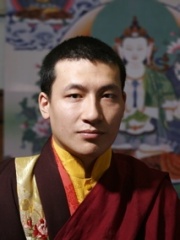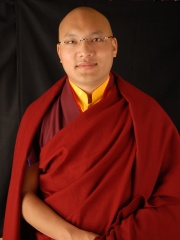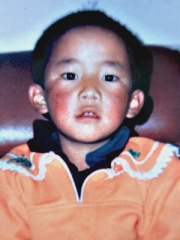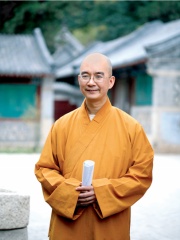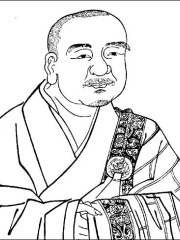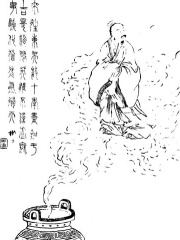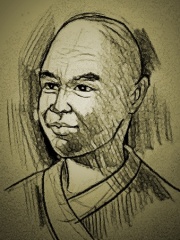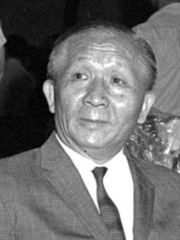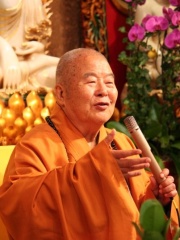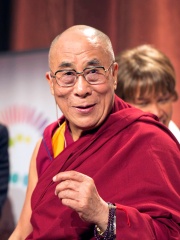
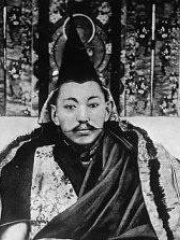
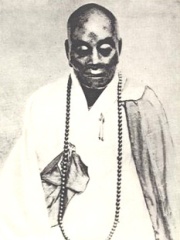
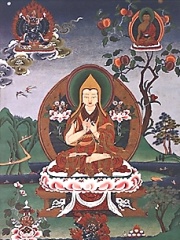
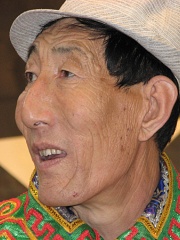
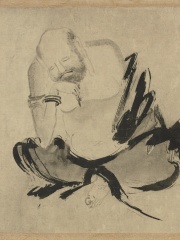
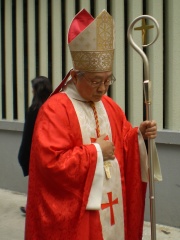
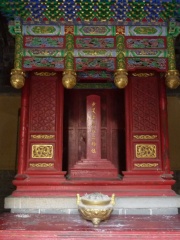
The Most Famous
RELIGIOUS FIGURES from China
This page contains a list of the greatest Chinese Religious Figures. The pantheon dataset contains 3,187 Religious Figures, 24 of which were born in China. This makes China the birth place of the 19th most number of Religious Figures behind Japan, and Switzerland.
Top 10
The following people are considered by Pantheon to be the top 10 most legendary Chinese Religious Figures of all time. This list of famous Chinese Religious Figures is sorted by HPI (Historical Popularity Index), a metric that aggregates information on a biography’s online popularity. Visit the rankings page to view the entire list of Chinese Religious Figures.

1. 14th Dalai Lama (b. 1935)
With an HPI of 78.14, 14th Dalai Lama is the most famous Chinese Religious Figure. His biography has been translated into 117 different languages on wikipedia.
The 14th Dalai Lama (spiritual name: Jetsun Jamphel Ngawang Lobsang Yeshe Tenzin Gyatso, also known as Tenzin Gyatso; né Lhamo Thondup; born 6 July 1935) is, as the incumbent Dalai Lama, the highest spiritual leader and head of Tibetan Buddhism. By the adherents of Tibetan Buddhism, he is considered a living Bodhisattva; specifically, an emanation of Avalokiteśvara in Sanskrit, and Chenrezig in Tibetan. He is also the leader and a monk of the Gelug school, the newest school of Tibetan Buddhism, formally headed by the Ganden Tripa. The central government of Tibet at the time of his selection, the Ganden Phodrang, invested the Dalai Lama with temporal duties until his exile in 1959.The 14th Dalai Lama was born to a farming family in Taktser (Hongya Village), in the traditional Tibetan region of Amdo (administratively Qinghai, Republic of China). He was selected as the tulku of the 13th Dalai Lama in 1937, and formally recognised as the 14th Dalai Lama in a public declaration near the town of Bumchen in 1939. As with the recognition process for his predecessor, a Golden Urn selection process was exempted and approved by the Central Government of the Republic of China. His enthronement ceremony was held in Lhasa on 22 February 1940 and he eventually assumed full temporal (political) duties on 17 November 1950 (at 15 years of age), after the People's Republic of China's occupation of Tibet. The Tibetan government administered the historic Tibetan regions of Ü-Tsang, Kham and Amdo.Subsequent to the annexation of Tibet by the People's Republic of China, during the 1959 Tibetan uprising, the Dalai Lama escaped to India, where he continues to live in exile while remaining the spiritual leader of Tibet. On 29 April 1959, the Dalai Lama established the independent Tibetan government in exile in the north Indian hill station of Mussoorie, which then moved in May 1960 to Dharamshala, where he resides. He retired as political head in 2011 to make way for a democratic government, the Central Tibetan Administration.The Dalai Lama advocates for the welfare of Tibetans and since the early 1970s has called for the Middle Way Approach with China to peacefully resolve the issue of Tibet. The Dalai Lama travels worldwide to give Tibetan Mahayana and Vajrayana Buddhism teachings, and his Kalachakra teachings and initiations are international events. He also attends conferences on a wide range of subjects, including the relationship between religion and science, meets with other world leaders, religious leaders, philosophers, and scientists, online and in-person. His work includes focus on the environment, economics, women's rights, nonviolence, interfaith dialogue, physics, astronomy, Buddhism and science, cognitive neuroscience, reproductive health and sexuality. The Dalai Lama was awarded the Nobel Peace Prize in 1989. Time magazine named the Dalai Lama one of the "Children of Gandhi" and Gandhi's spiritual heir to nonviolence.

2. 13th Dalai Lama (1876 - 1933)
With an HPI of 67.56, 13th Dalai Lama is the 2nd most famous Chinese Religious Figure. His biography has been translated into 52 different languages.
Ngawang Lobsang Thupten Gyatso Jigdral Chokley Namgyal, abbreviated to Thubten Gyatso (Tibetan: ཐུབ་བསྟན་རྒྱ་མཚོ་, Wylie: Thub Bstan Rgya Mtsho; 12 February 1876 – 17 December 1933) was the 13th Dalai Lama of Tibet, enthroned during a turbulent era and the collapse of the Qing Dynasty. Referred to as "the Great Thirteenth", he is also known for redeclaring Tibet's national independence, and for his reform and modernization initiatives. In 1878, he was recognized as the reincarnation of the Dalai Lama. He was escorted to Lhasa and given his pre-novice vows by the Panchen Lama, Tenpai Wangchuk, and named "Ngawang Lobsang Thupten Gyatso Jigdral Chokley Namgyal". In 1879, he was enthroned at the Potala Palace, but did not assume political power until 1895, after he had reached his maturity. Thubten Gyatso was an intellectual reformer and skillful politician. He was responsible for countering the British expedition to Tibet, restoring discipline in monastic life, and increasing the number of lay officials to avoid excessive power being placed in the hands of the monks.

3. Huineng (638 - 713)
With an HPI of 65.76, Huineng is the 3rd most famous Chinese Religious Figure. His biography has been translated into 30 different languages.
Dajian Huineng (traditional Chinese: 大鑒惠能; pinyin: Dàjiàn Huìnéng; Wade–Giles: Ta⁴-chien⁴ Hui⁴-nêng²; Japanese: Daikan Enō; Korean: Daegam Hyeneung; February 27, 638 – August 28, 713), also commonly known as the Sixth Patriarch or Sixth Ancestor of Chan (traditional Chinese: 禪宗六祖), is a semi-legendary but central figure in the early history of Chinese Chan Buddhism. According to tradition he was an uneducated layman who suddenly attained awakening upon hearing the Diamond Sutra. Despite his lack of formal training, he demonstrated his understanding to the fifth patriarch, Daman Hongren, who then supposedly chose Huineng as his true successor instead of his publicly known selection of Yuquan Shenxiu. Twentieth century scholarship revealed that the story of Huineng's Buddhist career was likely invented by the monk Heze Shenhui, who claimed to be one of Huineng's disciples and was highly critical of Shenxiu's teaching.Huineng is regarded as the founder of the "Sudden Enlightenment" Southern Chan school of Buddhism, which focuses on an immediate and direct attainment of Buddhist enlightenment. The Platform Sutra of the Sixth Patriarch (六祖壇經), which is said to be a record of his teachings, is a highly influential text in the East Asian Buddhist tradition.

4. Je Tsongkhapa (1357 - 1419)
With an HPI of 64.79, Je Tsongkhapa is the 4th most famous Chinese Religious Figure. His biography has been translated into 31 different languages.
Tsongkhapa ([tsoŋˈkʰapa], meaning: "the man from Tsongkha" or "the Man from Onion Valley", c. 1357–1419) was an influential Tibetan Buddhist monk, philosopher and tantric yogi, whose activities led to the formation of the Gelug school of Tibetan Buddhism. He is also known by his ordained name Losang Drakpa (Wylie: blo bzang grags pa, Skt. Sumatikīrti) or simply as "Je Rinpoche" (Wylie: rje rin po che, "Precious Lord"). He is also known by Chinese as Zongkapa Lobsang Zhaba or just Zōngkābā (宗喀巴).Tsongkhapa was born in Amdo, the son of a Tibetan Longben Tribal leader who also once served as an official of the Yuan dynasty. It is said that Tsongkhapa's father was probably a Mongolian because he was the head (darguchi. mong) of a Tibetan tribe of the Yuan dynasty (Mongol Empire). It is possible that a Tibetan philosopher was born from the family of a Mongolian leader. As a monk, Tsongkhapa studied under numerous teachers of the various Tibetan Buddhist traditions which flourished in central Tibet, including Sakya, Jonang, Kagyu and Kadam.Tsongkhapa was a prolific author with a broad knowledge of Buddhist philosophy, logic, hermeneutics and practice. He wrote numerous works on madhyamaka philosophy (such as Ocean of Reasoning, a commentary on the Mūlamadhyamakakārikā), Mahayana practice (such as Lamrim Chenmo), and Vajrayana (Great Exposition of Secret Mantra). His philosophical works are mainly a synthesis of the Buddhist epistemological tradition of Dignāga and Dharmakīrti and the madhyamaka philosophy of Nāgārjuna and Candrakīrti.According to John Powers, Tsongkhapa's work "contains a comprehensive view of Buddhist philosophy and practice that integrates sutra and tantra, analytical reasoning, and yogic meditation." Guy Newland describes Tsongkhapa's philosophical approach as one which combines the existence and validity of logic and ethics (conventionally and contingently) with "a radical view of emptiness" which sees all phenomena as devoid of intrinsic nature.According to Jay L. Garfield, Tsongkhapa also held that it was necessary to develop a correct view of the true nature of reality, and that to do this one had to engage in rigorous study, reasoned analysis and contemplation (alongside of meditation). As Garfield notes, this view of emptiness is not a kind of nihilism or a total denial of existence. Instead, it sees phenomena as existing "interdependently, relationally, non-essentially, conventionally" (which Tsongkhapa terms "mere existence").
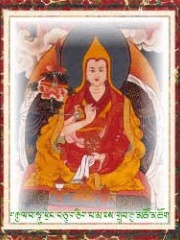
5. 11th Dalai Lama (1838 - 1856)
With an HPI of 59.63, 11th Dalai Lama is the 5th most famous Chinese Religious Figure. His biography has been translated into 39 different languages.
Khedrup Gyatso (1 November 1838 – 31 January 1856) was the 11th Dalai Lama of Tibet.He was recognised as the Eleventh Dalai Lama in 1840, having come from the same village as Kelzang Gyatso, the seventh Dalai Lama, had in 1708. In 1841, Palden Tenpai Nyima, 7th Panchen Lama, gave him the pre-novice ordination, cut his hair and gave him the name Khedrup Gyatso.In 1842, he was enthroned in the Potala Palace and, in 1849, at the age of eleven, he took the novice vows of monkhood from Palden Tenpai Nyima, 7th Panchen LamaHe was enthroned on 25 May 1842 and assumed full power on the request of his government on 1 March 1855. However, he died less than one year later, thus becoming the third successive Dalai Lama who died at too young an age to consolidate his power. "During the period of the short-lived Dalai Lamas—from the Ninth to the Twelfth incarnations—the Panchen was the lama of the hour, filling the void left by the four Dalai Lamas who died in their youth."He wrote a book of stanzas, Story of the Monkeys and Birds (Bya sprel gyi gtam-rgyud). It is an allegory of the war at the end of the 18th century between the Tibetans and the Gurkhas ('birds' and 'monkeys' respectively).During the life of Khedrup Gyatso, wars over Ladakh weakened the lamas' power over the Tibetan Plateau and the First and Second Opium Wars as well as the Taiping Rebellion simultaneously weakened Qing Empire's influence on Tibet. In the last years of his reign the Nepalese invaded Tibet, but were defeated in the Nepalese-Tibetan War (1855–1856). He died suddenly in the Potala Palace, Lhasa, Tibet, on 31 January 1856.

6. Bao Xishun (b. 1951)
With an HPI of 59.00, Bao Xishun is the 6th most famous Chinese Religious Figure. His biography has been translated into 24 different languages.
Bao Xishun (also known as Xi Shun; born November 2, 1951) is a Chinese herdsman from Chifeng, Inner Mongolia, recognized by Guinness World Records as one of the world's tallest living men at 7 feet 9 inches (236 cm) tall. He was formerly certified as the tallest living man by the Guinness World Records. On September 17, 2009, Sultan Kösen overtook Bao Xishun as the tallest living man.

7. Dazu Huike (487 - 593)
With an HPI of 58.65, Dazu Huike is the 7th most famous Chinese Religious Figure. His biography has been translated into 15 different languages.
Dazu Huike (487–593; Chinese: 大祖慧可; pinyin: Dàzǔ Huìkě; Wade–Giles: Ta-tsu Hui-k'o; Japanese pronunciation: Taiso Eka) is considered the Second Patriarch of Chan Buddhism and the twenty-ninth since Gautama Buddha. He was the successor to Bodhidharma.

8. Joseph Zen (b. 1932)
With an HPI of 58.21, Joseph Zen is the 8th most famous Chinese Religious Figure. His biography has been translated into 26 different languages.
Joseph Zen Ze-kiun, SDB (Wu Chinese pronunciation: [zəɲ zəʔ tɕyəɲ], born 13 January 1932) is a retired Chinese cardinal of the Catholic Church who served as Bishop of Hong Kong from 2002 to 2009. He was made a cardinal by Pope Benedict XVI in 2006 and has been outspoken on issues regarding human rights, political freedom, and religious liberty. Zen's strong ties with the pro-democracy camp often attract criticism from the pro-Beijing camp and the government of the People's Republic of China. He retired on 15 April 2009, but remains a strong pro-democracy influence in Hong Kong. On 11 May 2022 he was arrested by the National Security Police and later that day released on bail.

9. Shaohao (b. )
With an HPI of 57.57, Shaohao is the 9th most famous Chinese Religious Figure. His biography has been translated into 26 different languages.
Shaohao (Chinese: 少皞; pinyin: Shàohào; lit. 'Lesser brightness'), also known as Jin Tian (金天), was a legendary Chinese sovereign, usually identified as a son of the Yellow Emperor. According to some traditions, such as that within the Book of Documents, Shaohao is one of the Five Emperors. His place in the mythical lineage of the Yellow Emperor has been subject to controversy. Members of the 19th–20th century Doubting Antiquity School of historians posited that Shaohao was added to the orthodox succession legend by Liu Xin as part of a politically motivated campaign revising ancient texts c. 1 AD.
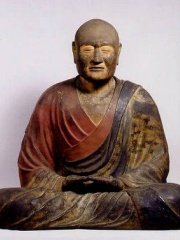
10. Jianzhen (688 - 763)
With an HPI of 55.59, Jianzhen is the 10th most famous Chinese Religious Figure. Her biography has been translated into 17 different languages.
Jianzhen (688–763), also known by his Japanese name Ganjin, was a Tang Chinese monk who helped to propagate Buddhism in Japan. In the eleven years from 743 to 754, Jianzhen attempted to visit Japan some six times, arriving in the year 753 and founding Tōshōdai-ji in Nara. When he finally succeeded on his sixth attempt, he had lost his eyesight as a result of an infection acquired during his journeys. Jianzhen's life story and voyage are described in the scroll, "The Sea Journey to the East of a Great Bonze from the Tang Dynasty."
People
Pantheon has 27 people classified as Chinese religious figures born between 101 and 1989. Of these 27, 7 (25.93%) of them are still alive today. The most famous living Chinese religious figures include 14th Dalai Lama, Bao Xishun, and Joseph Zen. The most famous deceased Chinese religious figures include 13th Dalai Lama, Huineng, and Je Tsongkhapa. As of April 2024, 3 new Chinese religious figures have been added to Pantheon including Dazu Huike, Witness Lee, and Hsing Yun.
Living Chinese Religious Figures
Go to all Rankings14th Dalai Lama
1935 - Present
HPI: 78.14
Bao Xishun
1951 - Present
HPI: 59.00
Joseph Zen
1932 - Present
HPI: 58.21
Trinley Thaye Dorje
1983 - Present
HPI: 39.84
Ogyen Trinley Dorje
1985 - Present
HPI: 39.17
Gedhun Choekyi Nyima
1989 - Present
HPI: 37.31
Xuecheng
1966 - Present
HPI: 36.20
Deceased Chinese Religious Figures
Go to all Rankings13th Dalai Lama
1876 - 1933
HPI: 67.56
Huineng
638 - 713
HPI: 65.76
Je Tsongkhapa
1357 - 1419
HPI: 64.79
11th Dalai Lama
1838 - 1856
HPI: 59.63
Dazu Huike
487 - 593
HPI: 58.65
Shaohao
HPI: 57.57
Jianzhen
688 - 763
HPI: 55.59
Sengcan
529 - 606
HPI: 55.14
Gan Ji
101 - 200
HPI: 54.60
Mang of Xia
HPI: 54.01
Yijing
635 - 713
HPI: 53.93
Rabban Bar Sauma
1220 - 1294
HPI: 53.77
Newly Added Chinese Religious Figures (2024)
Go to all RankingsOverlapping Lives
Which Religious Figures were alive at the same time? This visualization shows the lifespans of the 10 most globally memorable Religious Figures since 1700.

